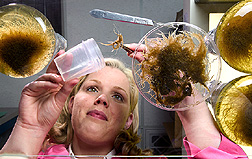This page has been archived and is being provided for reference purposes only. The page is no longer being updated, and therefore, links on the page may be invalid.
Read the magazine story to find out more. |
|
Cotton Roots Coaxed into Producing Promising Compound
By Erin PeabodyJuly 14, 2005
When it comes to cotton, it's usually the plants' soft, downy fibers that are the focus of Agricultural Research Service (ARS) scientists. But right now, what's getting their attention is a powerful compound extracted from the plants' roots. It has the potential to snuff out costly farm pests and diseases and perhaps even to guard against human cancers.
Called gossypol, the compound is found throughout the cotton plant, in its leaves, seeds and stems. However, methods for extracting large quantities of gossypol from those parts are limited. So ARS plant physiologist Barbara Triplett wondered if she could trick the plants into growing clumps of prolific hairy roots specially primed to produce gossypol.
What's so attractive about culturing hairy roots is that they can be conveniently grown in the laboratory to produce valuable compounds throughout the year.
Hairy roots can be started from almost any plant, as long as a researcher can provide the exact environmental conditions--including temperature, pH, nutrients and hormones--needed to coax the fine tangles of roots into culture.
Through much trial and error, Triplett, who works at ARS' Southern Regional Research Center in New Orleans, La., has discovered an ideal petri dish environment for growing fist-sized bunches of the gossypol-laden cotton roots.
Her colleague, SRRC chemical engineer Michael Dowd, confirms that the compound is actually present in the hairy roots and in the liquid medium surrounding them. He also monitors the quantities produced and the forms of gossypol appearing most potent.
After being extracted and purified, gossypol is, in its most essential form, a powder the color of ground mustard. With its only apparent weakness being sensitivity to sunlight, the intensely yellow compound is showing impressive antifungal, antibacterial and anticancer effects.
Dowd is providing gossypol samples to researchers from around the globe who are currently investigating the compound's glowing potential.
Read more about this research in the July issue of Agricultural Research magazine.
ARS is the U.S. Department of Agriculture's chief scientific research agency.

